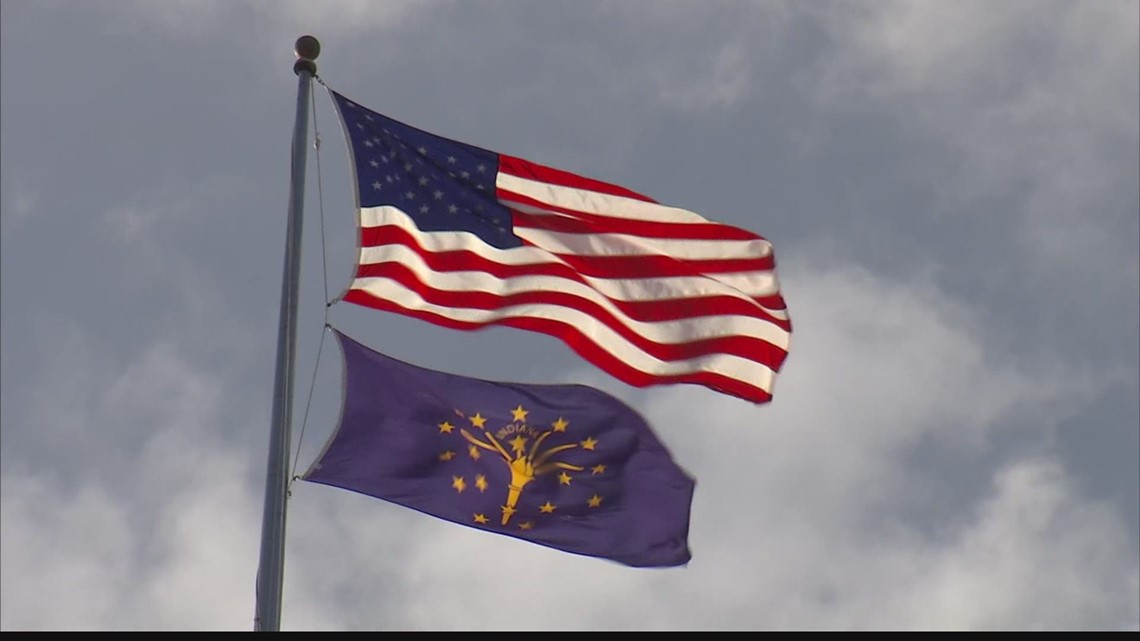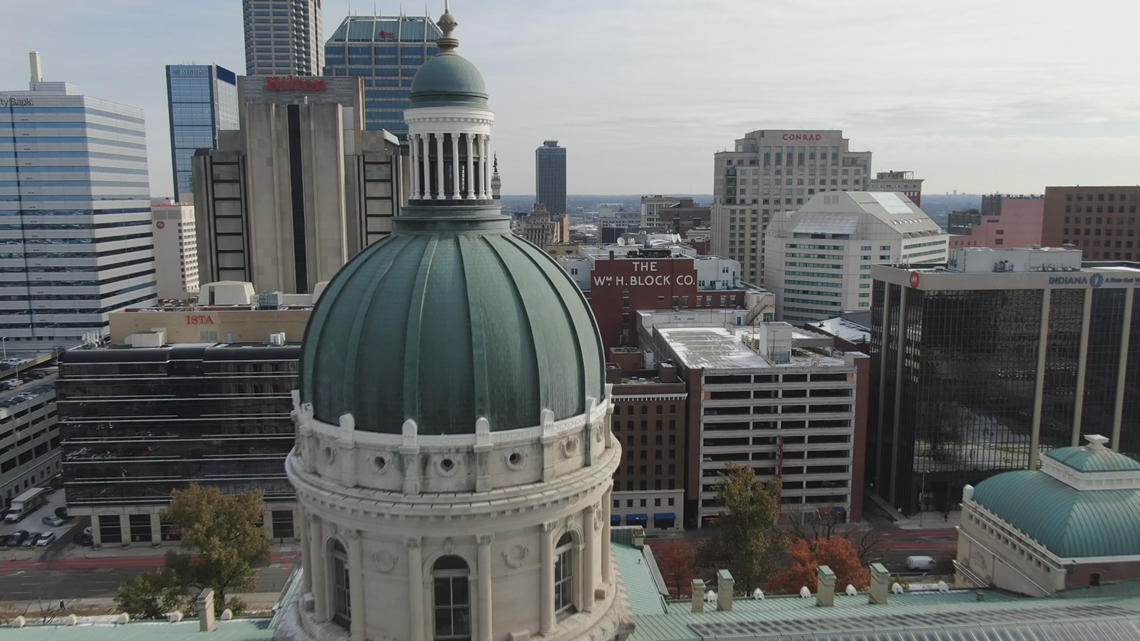INDIANAPOLIS — It’s a decades old practice used by legislators across the political spectrum to gain an edge over the opposing party come Election Day.
Gerrymandering is the act of manipulating congressional or legislative district maps in a way that gives that mapmaker’s party disproportionate power as a result.
It has long been scorned by voting rights activists and legal scholars.
This week, a new report commissioned by Women 4 Change said Indiana General Assembly and legislative maps are now more biased towards one party than 95% of maps enacted in other states across America.
Dr. Chris Warshaw is an Associate Professor of Political Science at George Washington University, and conducted the study on commission from Women 4 Change.
His work focuses on partisan gerrymandering, and he has analyzed data from nearly all 50 states for his research.
He found Indiana to be an extreme outlier.
“After the sort of wave elections in 2010, Republicans won control of all three level of both seats, both chambers in the state legislature, as well as the governorship. And so, with that power in hand, they were able to really draw maps that locked in their power. And I think all evidence we have indicates they did,” Warshaw said.
The report comes as the fight to have legislators redraw congressional districts in a more representative way has ramped up, as state lawmakers prepare to draw new districts for congressional seats, along with 100 Indiana House and 50 state Senate districts for the first time in a decade.
The Republican-dominated Legislature plans to vote on new maps later this year.
The process was delayed when the U.S. Census Bureau did not release the congressional and legislative redistricting data in the spring, citing delays due to COVID-19.
Given the supermajority within the Statehouse, voter rights organizations in Indiana said they are concerned lawmakers may have even less incentive to create maps that are representative of congressional district demographics in 2021 than they did in 2011.
“I would expect when one party controls the government, if there isn't massive public pressure against it, I think the gerrymanders will be even more aggressive than they were in 2010,” Warshaw said. “Indiana's already pretty aggressive, so I don't know how much more aggressive it could get. But I would expect it'll be even more biased in favor of Republicans after this next redistricting unless there is really strong public pressure to draw more fair maps.”


Dr. Sheila Kennedy is a law professor at O’Neill School of Public & Environmental Affairs at IUPUI and said both parties are guilty of gerrymandering when in positions to do so throughout history.
“The party in charge of drawing those lines in Indiana, it's Republicans. But in places like Maryland, it's Democrats. So this is an equal opportunity bad thing, if I may. But the party in charge draws those boundaries in ways that will favor their party and disfavor the other. So it ends up, in Indiana for example, they will shove all of the Democrats that they can into as few districts as possible and then sprinkle the rest of the districts out,” Kennedy said.
Organizations working to get district maps drawn in more representative ways say their end goal is not to flip whole districts from Party A to Party B.
“In Indiana, we would still be a Republican state in terms of the legislative makeup, but we wouldn't be a super majority state,” Kennedy said.
Warshaw also said a fair map in Indiana could very well still yield Republican victories – the races would just be more competitive, according to his findings.
Voting rights activists say it’s about creating districts where incumbents do not feel like wins are guaranteed, and voters feel accurately represented within their districts.
“Either we have country where we vote, we select our representatives - or our representatives select their voters. And what gerrymandering is, is allowing the representatives or the parties to select their voters. And that is not the way it is supposed to work,” Kennedy said.
Warshaw believes multiple factors contributed to the heavily gerrymandered state we see today.
Power given to a Republican supermajority back in 2010 granted Indiana Republicans nearly unrestrained power to divide congressional and legislative districts that would give them an edge in future elections.
“I'm not going to make some argument that they’re like nefarious or something. I think they just happen to control lots of state governments in 2010,” Warshaw said. “If you look over the arc of history, Democrats have also drawn lots of aggressive gerrymander and that, I think, hurt Republicans political voice. Having said that, in 2010, Republicans did draw the most aggressive recent gerrymander in general.”
Republicans also had access to better technology in 2010, which allowed gerrymanderers to pull more specific demographic and party information on constituents in order to better draw the district maps around party lines.
That was also happening within the context of a more polarized political climate. Where once it was hard to predict how voters would vote two or three elections in the future, Warshaw found the maps that were gerrymandered in 2010 were pretty spot on in 2020.
“It was just very hard to predict 10 years in the future what was going to happen. But in 2010, the current maps, they were like rock solid. You know, they dictate a little bit like the same map. The maps that were gerrymandered in 2010 basically held up in 2020,” Warshaw said.
Now, voting rights organizations across the state are doing what they can to mobilize Hoosier voters who feel a lack of representation in the Statehouse due to gerrymandering.
Julia Vaughn is a leader with Common Cause, a nonpartisan organization focused on promoting an “open, ethical, and accountable government for every Hoosier”, according to their website.
She says her organization has been focused on redistricting reform for the past six years. Vaughn points to frustrations she heard expressed by people living in Senate District 28, which includes the East Side of Indianapolis and much of Warren Township, then tapers into Hancock and Shelby Counties.
“Eight senators lives in Greenfield, and many of the folks who live in the Indianapolis part of the district just feel unheard,” Vaughn said. “I think it's an example of a community that can't fully express itself politically because of where the lines fall.”
Common Cause worked in collaboration with other voter’s rights organizations across Indiana to create Indiana Citizens Redistricting Commission, a bipartisan organization consisting of three Republicans, three Democrats, and three unaffiliated members who work to demonstrate how legislators could draw maps which represent their constituents.
Over the past few months, the Commission has hosted 10 public forums where people gathered to voice concerns about the way district maps are drawn affects them.
“The Citizens Redistricting Commission kept hearing in our public hearings earlier this year - the legislature doesn't listen to me. I write them, I call them. My organization invites them to public forums so that they can talk to voters. They don't even bother to respond. There's this feeling that the legislature is detached from the citizens,” Vaughn said.
Experts say feelings of disenfranchisement can result in low voter turnout rates, as voters feel the winner has won before the polls open.
“[Gerrymandering] creates voter apathy. Voter apathy isn't just well, I don't care what happens in my country. It's the result of saying, 'No matter what I do and in the voting booth - is it going to make a difference?'” Kennedy said.
Indiana ranked in the bottom 10 for voter turnout for the past decade, ranking last in 2014 across the United States.
For now, a legislative reprieve to Indiana’s gerrymander problems does not exist.


In 2020, five redistricting bills were introduced to the Legislature, which would have created a redistricting portal for citizens to draw maps and mandated joint hearings for more public input among other measures.
All died in committee.
In 2019, the Supreme Court ruled that partisan gerrymandering does not violate the Constitution.
That means the most likely change Indiana has to get more representative congressional map lines drawn for this upcoming decade lies in the people.
“Nobody these days relinquishes power simply because it's the right thing to do, or because it's good government. They're not going to willingly cede authority,” Kennedy said. “The question is, do we want to retain our position as a democratic republic? And do we believe that the people should rule?”
Lawmakers are expected to return to the Statehouse and approve new election districts sometime this fall.


